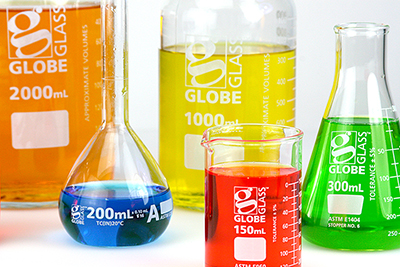

Cookies make our site work properly and securely. By using this website, you agree to our policy and will get the best user experience with brand enriched content & relevant products and services.


We know you have options when it comes to purchasing laboratory glassware. But not all glassware is created equal. In this blog, we will discuss reusable laboratory glassware, not including disposable or single-use items. Consider these five things when purchasing new glassware for your lab.
Glassware commonly used in laboratories includes beakers and flasks, media bottles, graduated cylinders, test tubes, and pipettes. These come in a wide range of sizes and are used for a variety of purposes. To ensure your glassware has the properties needed for laboratory use (like maximum chemical toughness), choose borosilicate glass.
Borosilicate glass is composed of boron trioxide, which allows for a low amount of thermal expansion — meaning that when exposed to extreme temperature changes, borosilicate glass won’t crack. Regular glass expands as a reaction to being heated, while borosilicate glass, like Pyrex, resists sudden temperature shifts that affect expansion rates and can damage regular glass.
In a laboratory setting, glassware is exposed to harsh chemicals, biological materials, and extreme temperatures. Glassware needs to hold up, or it can undermine the integrity of the lab work.
Globe Glass™ laboratory glassware is made exclusively from ASTM E438, Type I, Class A, 3.3 borosilicate glass. This glass has the ideal physical properties for use in laboratories, which include hydrolytic resistance (important for steam sterilization procedures), acid resistance (due to the high percentage of silica in the glass composition), alkali resistance, and, of course, temperature resistance.
To guarantee durability and resistance properties, laboratory glassware should pass basic testing criteria:
Besides durability and chemical resistance, glassware provides additional advantages in a laboratory setting, including dimensional stability (even at high temperatures) and transparency. These properties are important so that you can accurately observe reactions and read volumes. The Globe Glass™ product line is crystal-clear and come with easy-to-read dual graduations.
Although plastic has come to replace glassware for less-robust reactions, transparency and ease of cleaning make glassware a valuable addition to the lab. In fact, one of the durability tests involves how well glass surfaces resist marks or stains from acidic or alkali solutions. In addition, quality lab glass holds up to high-intensity disinfection methods to stay as clear and clean as the first use.
It is important to choose glassware that complies with global ASTM Standards — defined industry standards for laboratory glass and other materials — as this guarantees the absolute highest precision and tolerance (the permissible deviation of a specified value to still be considered accurate) associated with volumetric measurements.
Glassware used in a laboratory setting should meet a standard set of specifications, or specs, which ensure their precision and suitability for lab purposes. Glassware marked Class A signifies compliance with construction and accuracy requirements; glassware in the Class B category shares the same design specs but has volumetric tolerances twice that allowed for Class A glassware.
The ability to measure accurate volumes is critical to a lab’s performance — adhering to ASTM standards means your laboratory work is always compliant even when standards are updated (for example, a liter measurement was recently redefined as a cubic decimeter — glassware marked with either mL or cm3 complies with current specs). The Globe Glass™ product line comes with both Class A and Class B calibrations, meeting premium ASTM accuracy standards.
Finally, make sure that your shipment of laboratory glassware arrives intact with no cracks or shattered products. It’s a total bummer anytime something arrives broken, but when it comes to laboratory work, broken supplies can hinder a lab’s performance and timelines. Engineered to meet the hazards and rigors of transportation, GlassGuard™ packaging protects Globe Glass™ laboratory glassware during shipment. Robust packaging designs begin at the pack level and extend to the full case packaging. Heavy duty, multilayered corrugated container systems meet rigid quality standards and testing protocols to provide exceptional protection from damage, even in the small parcel shipping environment.Globe Glass™ comes packed in specially engineered cardboard containers to ensure product integrity during shipping.
When you partner with a vendor you can trust, both for quality and care of delivery, you can have complete confidence in the accuracy and efficiency of your lab workflow. To learn more about how we can fulfill your laboratory needs, reach out to Globe Scientific today!